Research Article
Is It Worth Participating in the Antenatal School Classes?
1234
Views & Citations234
Likes & Shares
Introduction: The Birth School is a modern compendium of knowledge about pregnancy, childbirth and puerperium. These schools were created out of the need to alleviate the pain of labor, which is caused by the general stress of the body, both physical and mental, as it is based on the fear of women facing this challenge. The assumption that it is education and providing a woman with the necessary knowledge about an unknown area of her life to help reduce her pain during childbirth is correct. Educating women, but also their partners, about the course of the delivery itself, as well as pregnancy and puerperium, contributes to the better comfort of a mother in labor who being aware of what is going to happen, what it is caused by and how it is going to end up at, can handle physical suffering much better.
Objective of the work:
- The main goal was to find out whether it is worth participating in the classes of the Birth School.
- The degree of preparation of women for pregnancy, childbirth and early motherhood.
- The degree of preparation fathers to actively participate in childbirth and care for the newborn.
Material and Methods: The diagnostic survey covered 400 women aged 15-45 who were pregnant in 2008-2012, including 176 (44%) women participating in childbirth classes (the study group) and 224 (56%) women not participating in school classes giving birth (control group). The data obtained as a result of the research was subjected to statistical analysis. Most of the childbirth school participants decided to give birth to the family. All primiparas found the antenatal course useful in preparing fathers to actively participate in childbirth and care for the newborn. The women with higher education, living in cities, participated in childbirth classes more often.
Results: The participation in the birthing school reduced fears and anxieties of parents related to pregnancy and childbirth, and facilitated active participation in childbirth and safely enter new parenting roles. Demographic factors such as place of residence, mother's age, marital status and education were significantly related to the participation of future mothers and fathers in childbirth classes.
Conclusions:
- Educating women and their partners about the course of childbirth, as well as pregnancy and the postpartum period, contributes to improving the comfort of the mother in labor.
- It strengthens the bond between spouses and facilitates the care of the newborn.
- It was found that it is worth participating in the Nativity School classes as it is a source of professional knowledge passed on by specialists.
- The popularity of Birth Schools in Poland increases every year.
Keywords: Pregnancy, Childbirth, Birthing school, Popularization
INTRODUCTION
The Birth School is a modern compendium of knowledge about pregnancy, childbirth and puerperium. These schools were created out of the need to alleviate the pain of labor which is caused by the general stress of the body, both physical and mental as it is based on the fear of women facing this challenge. The arrival of a child into the world is an extremely important event in the family, full of emotions and love. Femininity is the belief that we are made to give birth to a child as beautiful as we can imagine. The waiting time for the birth of a child is the period of greatest motivation for parents to acquire theoretical and practical knowledge. They enter new roles - mother and father. Contemporary birth schools are places that prepare people to fulfill these roles at the stage when the child is in the womb [1-3].
OBJECTIVE OF THE WORK
The main goal was to find out whether it is worth participating in the classes of the Birth School which is a source of professional knowledge passed on by specialists.
MATERIAL AND METHODS
Before starting the research, the following qualification criteria were established: written consent to participate in the research, and in the study group - systematic attendance at all classes in the birthing school. The research was based on a diagnostic survey. The research tool was a questionnaire. The structure of the questionnaire made it possible to assess the degree of preparation of women for pregnancy, childbirth and early motherhood and fathers for active participation in childbirth as well as for taking care of the newborn.
The program of classes at the birthing school included:
- theoretical issues, I. e pregnancy physiology, newborn care, natural feeding
- systemic and breathing exercises, including learning to breathe through the diaphragmatic path
- relaxation (music therapy, visualization)
Theoretical and practical classes were conducted by professionals - midwives, gynecologists - obstetricians, dieticians, physiotherapists and psychologists. The women started their education in the 25th week of pregnancy. The classes were held twice a week and lasted 90 min. To conduct the study, it was necessary to prepare a research tool. For this purpose, an original questionnaire was constructed. When developing the research tool, efforts were made to take into account the formal requirements defined by the methodological literature and to link the constructed questions with the main problem of the work. In this study, the method of a diagnostic survey was used, with the use of the questionnaire technique. The diagnostic survey method is defined, inter alia, as a method of collecting knowledge about the opinions and views of selected communities, intensification and directions of these phenomena based on the study of the group in which these phenomena occur. While characterizing the structure of the questions in the survey, it was stated that they should be specific, precise and concern one problem. Each of the questions is related to the so-called cafeteria, i.e., a set of possible answers. Therefore, closed cafeterias were used (a limited set of possible answers beyond which the respondent cannot go out), semi-open (containing the point "other - what?"), Conjunctive (allowing the selection of several answers) and disjunctive (only one answer). The research tool was a questionnaire constructed for the purpose of the study. Before starting the collection of research material during the meeting, the participants of the survey were informed by the person conducting the survey about their voluntary participation in the research and guaranteeing their full anonymity.
STATISTICAL METHODS USEDThe data obtained as a result of the research were subjected to statistical analysis. Various statistical methods were used in the study, depending on the assumed partial research objectives. The following measures of descriptive statistics were used to characterize the studied groups and variables: counts, means, median, standard deviation and percentage fractions.A 5% inference error was assumed. Therefore, p = 0.05 was adopted as the border value of the level of statistical significance. P values> 0.05 indicated statistically insignificant differences. On the other hand, p
RESULTS
The study covered 400 women aged 15-45 who were pregnant in 2008-2012, including 176 (44%) women participating in childbirth classes (the study group) and 224 (56%) women not taking part in childbirth classes (control group).
In both surveyed groups, the majority of women were city dwellers (93.5%), while 6.5% of women lived in rural areas. The analysis of the place of residence showed that there was an advantage of families living in small towns and large cities in relation to families living in the countryside. The women and men included in the study came from different backgrounds and age groups with different education. The mean age of the women was 29.7. The study group was x = 29.5, and in the control group x = 29.88 The mean age of women giving birth and its differentiation in the study group and the control group are presented in Figure 1.
The demographic changes initiated in the 90s of the last century resulted mainly in the shift of the highest fertility of women in the age group 20-24 years for the group of 25-29 years. As a consequence, fertility increased significantly in the age group of 30-34 years, which is mainly the realization of "postponed" births. Most pregnant women were aged between 25 and 29 (38.3%). Mothers, after 30 years of age accounted for 33%. The youngest mother was 18 (2%), the oldest - 42 (1%). The percentage of women over 40 years old differed significantly in both groups (p = 0.03), while the percentage of women under 20 years old did not (p = 0.06). The education level of the mother and father in both groups is presented in Figure 2.
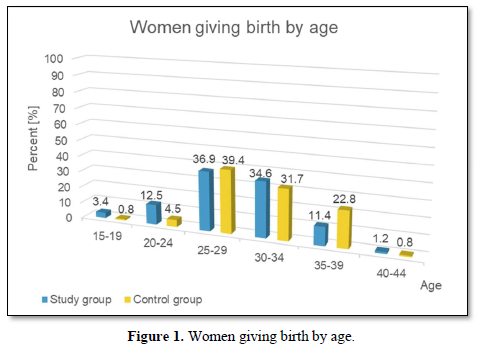
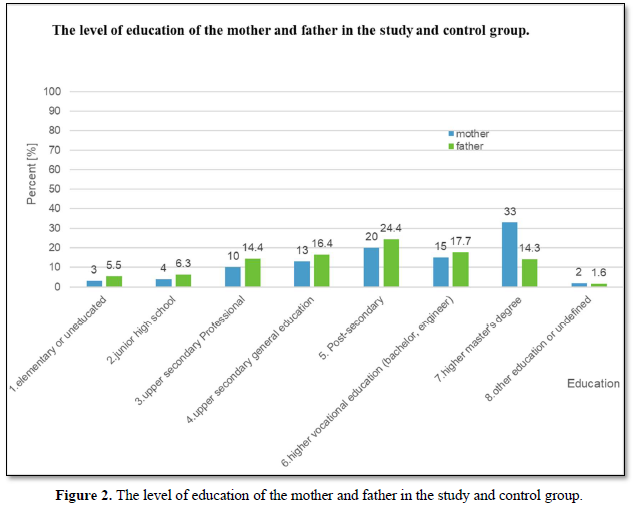


Both in the study group and in the control group, a greater percentage of mothers than fathers had higher education. The percentage of mothers and fathers differed statistically significantly in the case of parents with vocational upper secondary education (p = 0.0), general upper secondary (p = 0.02), post-secondary (p = 0.04) and graduate education (p = 0.0)). The marital status of mothers in the study group and the control group is shown in Figure 3.
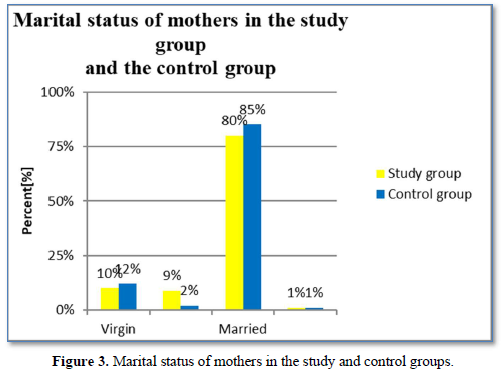

In the analysis of the marital status of mothers, married (married) and other women were listed, i.e., unmarried women, divorced women and women living in free relationships. Both in the study group (80% of mothers) and in the control group of children (85% of mothers), the vast majority of mothers were married. Full families accounted for the majority of over 80% of cases. The incompleteness of the structure of 1% of families was caused by the divorce of the spouses, i.e., 4 women in the study group and 3 women in the control group. 4.5 times more women in the test group than in the control group lived in free relationships. The maidens who gave birth to children were 2% more in the control group. The widows did not take part in the study. On this basis, it can be concluded that over 4/5 of the examined children were raised in full natural families. Demographic factors such as place of residence, mother's age, marital status and education were significantly related to the participation of future mothers and fathers in childbirth classes. The responses to the question about sources of information on pregnancy, childbirth and care for a newborn baby are presented in Figure 4.
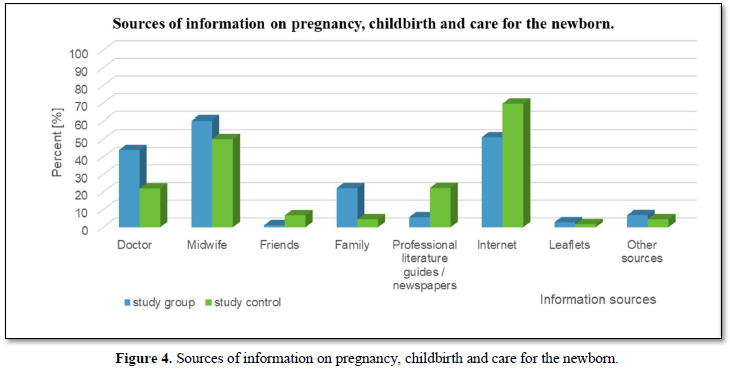

The number of responses is greater than the number of respondents because the respondents gave more than one answer These data show that women who did not attend childbirth classes more often used the midwife's advice 50% (n = 112), searched for information in the Internet (69.6%; n = 156) and professional literature (22.3%; n = 50). In the next question, the respondents answered what was the motivation to participate in the childbirth school. The results are presented in Figure 5.
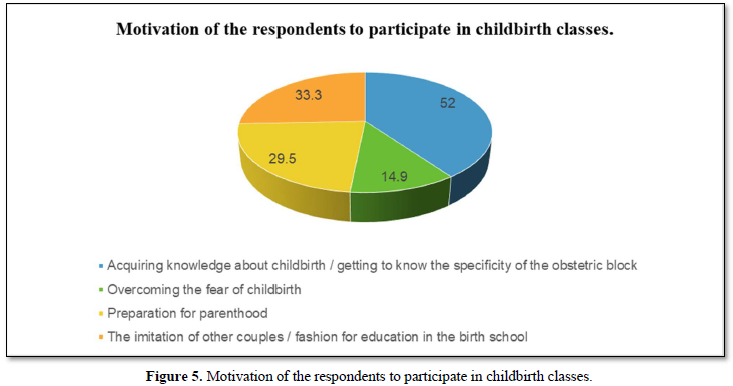

The number of responses is greater than the number of respondents because the respondents gave more than one answer.
The results indicate that the reason for participating in the birthing school was: learning about childbirth / getting to know the specificity of the obstetric block (92 people; 52%), overcoming the fear of childbirth (26 people; 14.9%). Preparation for parenthood (52 people; 29.5%) and imitation of other couples / fashion for education in the birth school (58 people; 33.3%) (Figure 6).
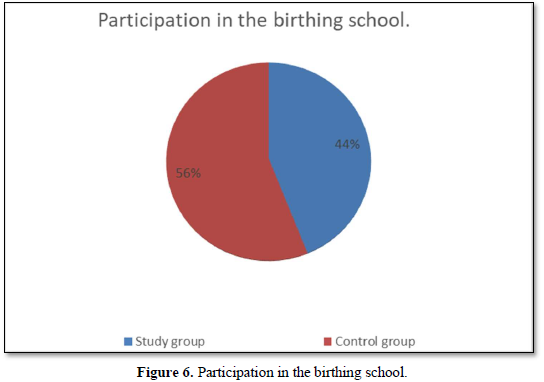

The study covered 400 women aged 15-45 who were pregnant in 2008-2012, including 176 (44%) women participating in childbirth classes (the study group) and 224 (56%) women not taking part in childbirth classes (control group).
Most of the respondents attended childbirth school with a companion, including a spouse or partner - 65.1%, a close relative - 6.1%, with a friend or friend - 3.1%, the remaining 25.7% responded that they themselves were educated in the birthing school (Figure 7).
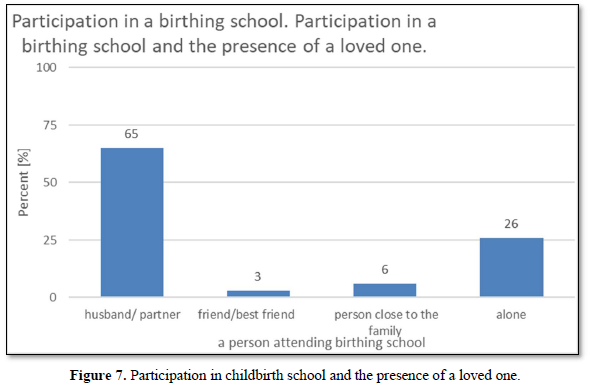

Primary women in the control group (72%; n = 162) reported general fatigue more often. Pain in the back, lower limbs and other ailments (nausea, vomiting, dyspnea, swelling of the lower limbs occurred in every third or every fourth respondent, regardless of belonging to the group. 135 primiparous women (77% of the group) attending the antenatal course found the knowledge of the range of skills to alleviate the inconvenience and pain associated with pregnancy. (Figure 8).
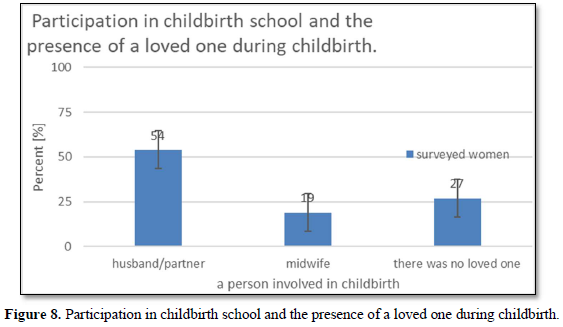

According to 54.6% of respondents, the husband / partner was the most desirable person in the delivery room. The respondents also noticed the need for the presence of a midwife from the birth school (19%), which indicates the need for continuity of care during pregnancy, childbirth and puerperium in order to use the acquired knowledge, including techniques supporting the natural birth mechanism. Among the surveyed women, 26.8% did not have a loved one with them during childbirth (Figure 8). Family childbirth has a positive effect on the birth condition of newborns, which is a statistically significant result. Research shows that childbirth classes are a good form of conscious preparation for childbirth, including family birth that has been promoted for many years. According to numerous studies, the presence of a loved one in childbirth school and during childbirth provides great mental and physical support for the mother in labor.
Most of the deliveries ended with the method of cesarean section - 262 deliveries, and only in 138 cases were vaginally delivered. Participation in childbirth classes had no effect on the way of pregnancy termination.
DISCUSSION
The first Birth Schools were established in Great Britain in the 1940s. They have been developing in Poland since 1956. They function as separate (private) institutions or at units such as clinics, hospitals, private offices, fitness clubs, or even marriage and family clinics or parishes. Birthing school is a training course preparing for childbirth and motherhood. The Birth School is recommended for both pregnant women and future fathers. Their functioning, on the one hand, very standardized, and on the other hand, very individual in the approach to future parents. It allows for the feeling of uniqueness of the waiting time for a child, but also for getting rid of the fears and fears that often accompany future parents [1-3]. It is often heard that nobody needs childbirth school, after all, women gave birth and no one taught them to do so. how they were not taught to be mothers and wives. This is not true. Civilization progress, changing the family model, the so-called Professional careers of women mean that women often have the first contact with a child only when it is their child [4]. In order for women to take full advantage of the available solutions of modern obstetrics and to actively prepare for childbirth throughout pregnancy, it is important to educate women about modern methods of delivery [3]. Such education is now provided by the Birth Schools. They promote and broaden the knowledge about pain relief methods during natural childbirth, prepare the woman and her partner both physically and mentally to consciously participate in the act of giving birth [5]. The goals of antenatal education include acquainting women with changes taking place in her body during pregnancy, teaching the ability to distinguish physiological from pathological phenomena, and appropriate response when the latter appear. The own results obtained in this study are confirmed by research carried out both in Poland and abroad. Spiby et al. Demonstrated the need to properly transfer knowledge about the course of pregnancy and childbirth in such a way that the information obtained would have a practical counterpart [6]. The problem of effective information transfer is discussed in Stamler's work [7]. He believes that general assumptions regarding both the content and the way in which it is taught in antenatal education courses are necessary. Only then, according to the author, do pregnant women obtain theoretical and practical information in the best and most effective way. The ratio of pregnant women to childbirth has changed dramatically in recent years. According to Kosińska [8], it manifests itself in women's search for information on the physiology of pregnancy and childbirth. Ziółkowska [9-11] and Stanley A [12] note that not only theoretical preparation, but also the possibility of applying the obtained knowledge in practice, strengthens faith in one's own abilities during childbirth and effectively reduces the anxiety associated with it. The Birth School has a positive impact on the course of childbirth and the condition of the newborn [10]. The results of our own research indicate that more than half of the participants of Birth Schools are pregnant women up to the age of 30. These results are confirmed in the studies of other authors [3] Szałkowski [11] and Stangret [12]. Pregnancy, especially the first one, is a great experience for future parents and their relatives. This is undoubtedly justified by the lesser experience of motherhood by younger women. This is evidenced by the fact that 58.5% of the surveyed women participated in childbirth classes for the first time. This allows us to believe that the first pregnancy is associated with a lack of professional knowledge and practical experience, which prompts women to educate in this direction. Stangret [9] showed the need for adequate and effective transfer of knowledge about the course of pregnancy and childbirth, so that it would have its counterpart in practice. Participation in childbirth classes is currently recommended by the Polish Gynecological Society as a form of preparing a pregnant woman for childbirth and early motherhood [13]. Participation in childbirth classes is constantly growing in popularity. It is related to the growing awareness of young (not always age) parents who have a need to acquire knowledge, develop and improve their skills. as emphasized by researchers from various centers [14,15]. According to many authors, the low attendance of multiparous women in childbirth schools is probably due to the fact that a previous delivery is a sufficient experience and preparation for the next act of birth [8,9]. Women expecting their first child, better educated, living in cities [15] participate in the classes more often. These data are consistent with the reports of Polish authors as well as those from other regions of Europe, as well as the United States and Canada [16]. Women after antenatal courses are characterized by a more hygienic lifestyle: no addictions and a healthier diet, which is reflected in a lower weight gain during pregnancy. Our observations are consistent with the results of other researchers [17,18]. On the basis of the above information, it can be concluded that special emphasis is placed on promoting health and promoting the idea of schools giving birth should occur especially among women with primary and vocational education, living in the countryside [16]. Women physically active during pregnancy were characterized by better well-being and a lower level of perceived stress. Among women exercising during pregnancy, participants of childbirth classes constituted a much larger group. Women's physical activity significantly decreased with the following weeks of pregnancy [19] In Poland, the idea of family births has developed in recent years. The participation of both parents in the act of childbirth influences conscious parenting, strengthening the spiritual bond of parents and the development of the child's personality [11,20,21]. The Best Birth School is one that suits the needs and capabilities of parents preparing to welcome their child to the world. Research by Deluga and co-workers as well as own research shows that the vast majority of parents (96.4%) believe that one should prepare for the birth of a child [22]. was helpful and found practical application in childbirth, while 40% of women considered that the birth school also prepared them for early parenthood [23]. In conclusion, it should be emphasized that at present, due to the pandemic situation, classes are conducted online with a proposal that meets the needs of modern parents. Online birthing schools, which are most often not only a source of information, but also full courses intended for parents waiting for the birth of their offspring. Thanks to the use of e-learning in a practical way, you can prepare for childbirth without leaving home.
According to the parents' opinion, they are glad that such a program has been created because, unfortunately, there is no childbirth school in their place of residence Antenatal education is of great importance for parents. All respondents believed that it was right and necessary to prepare at school for giving birth to pregnancy and the puerperium. The real benefits of attending antenatal birthing classes were evident in the satisfaction of both parents after childbirth. They also argued that it was necessary to organize birthing schools., which is a source of expertise provided by specialists. It is worth participating in the classes.
Based on the survey research, conclusions were drawn:
- Education of women and their partners in the course of childbirth itself, as well as pregnancy and puerperium, contributes to improving the comfort of the mother in labor.
- It strengthens the bond between spouses and facilitates the care of the newborn.
- It was found that it is worth participating in the Nativity School classes as it is a source of professional knowledge passed on by specialists.
- The popularity of Birth Schools in Poland increases every year.
- Brzozowska MA, Walicka CK (2007) Comparison analysis of readiness for labor, among women in Poland, Sweden and the USA. Ann Uniwersytet Rzeszowski. pp: 42-46.
- Piziak W (2009) The influence of psychophysical preparation in the school of childbirth on the course of pregnancy and childbirth. Rzeszów: Med Rev Uni Rzeszówski 3: 282-292.
- Puszczałowska LE, Mokrzycka K, Jandziś S (2016) The impact of prepartum education on the course of pregnancy, childbirth and early motherhood. Gen Med Heal Sci 22(4): 264.
- Bączyk G, Cebulska V, Koźlak V, Michalak M, Bajek A (2011) The level of prepartum anxiety in pregnant women. Probl Hig 92: 774-777.
- Grochans E, Łuszczyńska V, Ćwiek D, Gorzkiewicz B (2003) Educational activity of the birthing school. Nursing XXI Century 24: 69-73.
- Spiby H, Henderson B, Slade P, Escott D, Fraser RB (1999) Strategies for copying with labor: Does antenatal education translate into practice? J Adv Nurs 29(2): 388-394.
- Stamler LL (1998) The participants´ views of childbirth education: is there congruency with an enablement framework for patient education? J Adv Nurs 28(5): 939-947.
- Kosińska K (2005) Attitudes of pregnant women towards childbirth - analysis of forms of preparation and preferences. Gynecol Poland 76(12): 973-978.
- Ziółkowska K, Marianowski L (2002) School of childbirth at the gynecological and obstetric department and the Clinic of the Medical University of Warsaw - analysis of activities, goals and assumptions. Clin Per and Gyn 25: 208-214.
- Kwiatek M, Gęca T, Biegaj FJ (2011) Szkoła giving birth - Profi l patients and the impact of classes on the course of childbirth and the condition of the newborn. Gen Med 17: 111-115.
- Szałkowski A (2002) Analysis of the course and manner of ending childbirth in patients after the Course at the birthing school. Clin Perin Gyn 25: 201-207.
- Stangret A, Cendrowska A, Szukiewicz D (2008) The influence of the School of Childbirth on the subjective assessment of theoretical and fitness preparation for childbirth. New Med 2: 2-6.
- Recommendations of the Main Board of PTG in the field of prenatal care in pregnancy with a normal course (2005) Available online at: http://www.femmed.com.pl/wp-content/uploads/2013/02/rekomendacjaopiekaprzedporodowa.pdf
- Wdowiak A, Kędzierska A, Sadowska M (2013) Effectiveness of childbirth schools in the opinion of women. Eur J Med Tech 1: 39-47.
- Olejniczak D, Krakowiak K (2013) Assessment of the need for health education of pregnant women in the field of lifestyle and breastfeeding. New Pediatr 3: 97-105.
- Kołomyjec P, Suchocki S, Kędra-Rakoczy M (2007) Education and health-promoting behavior of pregnant women taking part in childbirth school classes and their impact on the course of childbirth and the condition of the newborn. Wedge Perin Gin 43(3): 57-60.
- Consonni EB, Calderon IM, Consonni M, De Conti MH, Prevedel TTs, et al. (2010) A multidisciplinary program of preparation for childbirth and motherhood: maternal anxiety and perinatal outcomes. Reprod Health 29(7): 28.
- Ćwiek D, Grochans E, Sowinska-Glugiewicz I, Wysiecki P (2004) Analysis of some pro-health behaviors of pregnant women aft er a childbirth education class. Wiad Lek 57(1): 48-51.
- Ćwiek D (2012) Analysis of physical activity undertaken by women during pregnancy. Perinatol Neonatal Ginekol 5(1): 51-54.
- Ćwiek D, Torbe A, Gutowska CD, Czajka R (2002) The role of the birthing school and the family birth clinic in preparing parents for childbirth. Clinical Perinatology and Gynecology. Modern childbirth. [ed.]: Słomko Z and others Tychy. Available online at: https://www.izbapiel.katowice.pl/attachments/article/2041/Listy_Czy_warto_certyfikowac_szkoly_rodzenia.pdf
- Ulman WI, Poręba A, Kwiatkowska E, Szafarczyk A (2007) Childbirth with the participation of the father - influence on the formation of ties in the family. Clin Per Gyn 43(3): 52-56.
- Deluga A, Olkuska E, Ślusarska B (2012) Parents’ knowledge of the neonatal period and their expectations towards nurses and midwives. Gen Med Health Sci 8(4): 281-286.
- Puszczałowska LE, Mokrzycka K, Jandziś S (2016) The impact of prenatal education on the course of pregnancy, childbirth and early motherhood. Gen Med Health Sci 22(4): 264-269.
QUICK LINKS
- SUBMIT MANUSCRIPT
- RECOMMEND THE JOURNAL
-
SUBSCRIBE FOR ALERTS
RELATED JOURNALS
- Journal of Psychiatry and Psychology Research (ISSN:2640-6136)
- Journal of Carcinogenesis and Mutagenesis Research (ISSN: 2643-0541)
- Chemotherapy Research Journal (ISSN:2642-0236)
- Archive of Obstetrics Gynecology and Reproductive Medicine (ISSN:2640-2297)
- Journal of Pathology and Toxicology Research
- Journal of Allergy Research (ISSN:2642-326X)
- Journal of Rheumatology Research (ISSN:2641-6999)









